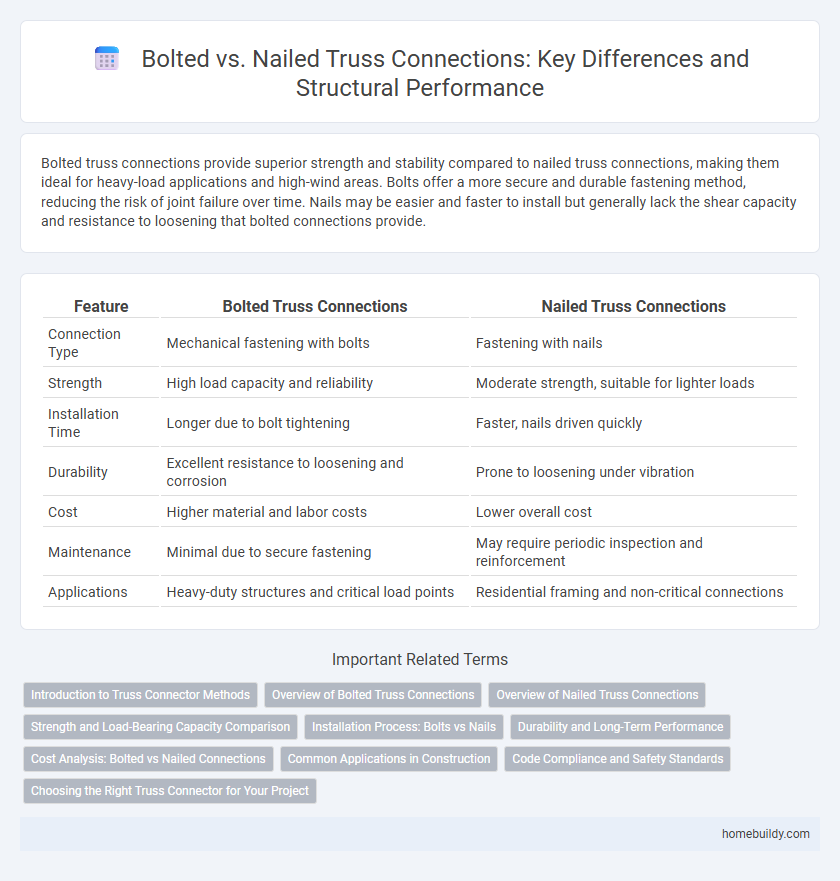Bolted truss connections provide superior strength and stability compared to nailed truss connections, making them ideal for heavy-load applications and high-wind areas. Bolts offer a more secure and durable fastening method, reducing the risk of joint failure over time. Nails may be easier and faster to install but generally lack the shear capacity and resistance to loosening that bolted connections provide.
Table of Comparison
| Feature | Bolted Truss Connections | Nailed Truss Connections |
|---|---|---|
| Connection Type | Mechanical fastening with bolts | Fastening with nails |
| Strength | High load capacity and reliability | Moderate strength, suitable for lighter loads |
| Installation Time | Longer due to bolt tightening | Faster, nails driven quickly |
| Durability | Excellent resistance to loosening and corrosion | Prone to loosening under vibration |
| Cost | Higher material and labor costs | Lower overall cost |
| Maintenance | Minimal due to secure fastening | May require periodic inspection and reinforcement |
| Applications | Heavy-duty structures and critical load points | Residential framing and non-critical connections |
Introduction to Truss Connector Methods
Bolted truss connections offer superior structural integrity and are preferred for their ability to withstand heavy loads and resist shear forces effectively. Nailed truss connections, while faster to install, may compromise long-term durability due to potential loosening and lower load capacity. Understanding the differences in load distribution and material compatibility is essential when selecting the appropriate truss connector method for construction projects.
Overview of Bolted Truss Connections
Bolted truss connections offer superior structural stability and load-bearing capacity compared to nailed connections by using high-strength steel bolts to create rigid joints. These connections enhance durability and reduce the risk of joint failure under dynamic or heavy loads, making them ideal for complex or high-stress truss systems. Installation requires precise alignment and torque specifications to ensure optimal performance and safety in timber framing applications.
Overview of Nailed Truss Connections
Nailed truss connections, commonly used in residential and light commercial construction, rely on multiple nails driven through truss members to structurally join components. These connections provide adequate shear resistance and ease of assembly while allowing some flexibility under load, making them suitable for typical wood truss systems. Proper nail spacing and size according to building codes are critical to maintain the strength and durability of nailed truss connections.
Strength and Load-Bearing Capacity Comparison
Bolted truss connections provide superior strength and load-bearing capacity compared to nailed truss connections due to the greater shear resistance and clamping force of bolts. Bolts create a secure, rigid joint that better withstands dynamic loads and heavy stresses, essential for structural stability in complex frameworks. Nail connections, while faster to install, exhibit lower withdrawal resistance and are more susceptible to loosening under cyclic loading, reducing overall load-bearing performance.
Installation Process: Bolts vs Nails
Bolted truss connections require precise alignment of bolt holes and the use of specialized tools such as torque wrenches for secure fastening, ensuring a strong mechanical bond. Nailed truss connections involve quicker installation with pneumatic nail guns, allowing rapid placement but potentially less uniform load distribution. The bolted process demands more time and skill, while nailed connections offer efficiency but may compromise long-term stability under heavy loads.
Durability and Long-Term Performance
Bolted truss connections offer superior durability and long-term performance compared to nailed connections, as bolts provide a stronger and more rigid joint that resists loosening and metal fatigue over time. Unlike nails, bolts enable better load distribution and maintain structural integrity under heavy or fluctuating loads, significantly reducing maintenance requirements. This makes bolted connectors ideal for trusses in critical applications where longevity and safety are paramount.
Cost Analysis: Bolted vs Nailed Connections
Bolted truss connections typically incur higher initial costs due to the price of bolts, washers, and labor-intensive installation processes, while nailed connections benefit from lower material and faster assembly costs. Over the long term, bolted connections offer greater durability and reduced maintenance expenses compared to nailed connections, which may suffer from loosening and require frequent inspections or repairs. Considering lifecycle cost analysis, bolted connections present a more cost-effective solution for structural integrity in high-stress applications despite the upfront investment.
Common Applications in Construction
Bolted truss connections are commonly used in commercial and industrial construction due to their high strength and precision, providing reliable load transfer and ease of disassembly for maintenance. Nailed truss connections are prevalent in residential and light-frame construction, offering faster installation and cost-effectiveness for projects with lower load demands. Both connection types are selected based on structural requirements, construction speed, and budget constraints.
Code Compliance and Safety Standards
Bolted truss connections offer superior code compliance by meeting strict structural requirements outlined in standards such as the International Building Code (IBC) and American Wood Council (AWC) guidelines, ensuring optimal load transfer and resistance to shear forces. Nail connections, while commonly used, often require additional validation through testing and may have limitations in meeting design values for uplift and lateral loads under ANSI/TPI 1 standards. Safety standards prioritize bolted connections due to their enhanced durability, predictability, and reduced risk of joint failure in critical truss assemblies.
Choosing the Right Truss Connector for Your Project
Bolted truss connections offer superior strength and durability compared to nailed truss connections, making them ideal for projects requiring enhanced structural integrity. Choosing galvanized steel bolts ensures corrosion resistance and long-term stability, critical for outdoor or high-moisture environments. Proper selection of truss connectors, considering load requirements and environmental conditions, optimizes performance and safety in construction projects.
Bolted truss connections vs nailed truss connections Infographic

 homebuildy.com
homebuildy.com